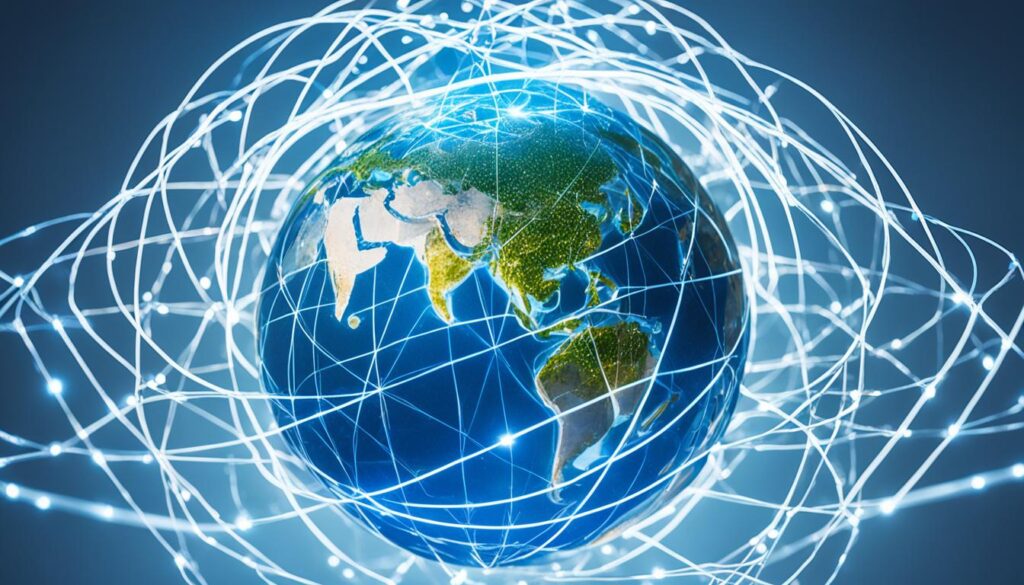Communication has been key to human life, changing from simple signals to today’s digital tech. This story takes us through the history of communication. It shows how we’ve changed over time, making our societies what they are.
We’ve moved from smoke signals and drumbeats to smartphones. The evolution of communication shows our creativity and need to connect across distances. By looking at the history of information technology, we see how far we’ve come to our current connected world.
Let’s start this exciting journey together. We’ll look at key moments and innovations in communication history. From ancient signals to digital platforms, we’ll see how communication has changed us and our world.
Ancient Origins: Smoke Signals and Drumbeats
In the early days, our ancestors used simple ways to talk to each other and plan things. Smoke signals and drumbeats were key for sending messages and keeping groups together. These methods were important for sharing stories, taking part in rituals, and showing who they were.
Prehistoric Communication Methods
Smoke signals were a key way to talk back then. By managing smoke from fires, people could send messages far away. The color, pattern, and how long the smoke lasted told different stories, helping communities talk over long distances.
Drumbeats were also crucial for communication. They could be heard for miles, and different beats meant different things. The drums themselves were special, showing the culture and beliefs of the people who used them.
Cultural Significance of Early Communication
These ways of communicating were more than just for sending messages. They were a big part of the culture and traditions of the people. Sending smoke signals or drumming was often a spiritual act, linking the now to the past and the community together.
Looking into these old ways of communicating teaches us a lot about how humans evolved. It shows how our ancestors were creative and found new ways to stay connected and overcome challenges.
The Dawn of Writing
The history of writing is a fascinating journey through human communication’s evolution. It began with the early cuneiform scripts of Mesopotamia and the hieroglyphics of ancient Egypt. These writing systems changed everything by making it easier to share information and record cultural traditions, laws, and events.
The creation of these early writing systems took centuries. It was a slow process that grew with human civilization. As people needed to keep track of information more, writing evolved from simple pictures to complex scripts. This shows how human societies became more complex and wanted to communicate better.
Switching from oral stories to written records was a big change. Writing on materials like clay tablets, papyrus, and parchment changed how knowledge was shared and kept. This led to the growth of administrative, legal, and religious systems. It also helped start literature, poetry, and other arts.
The story of writing shows how creative and flexible the human mind is. As societies grew, so did their writing, with new scripts and methods coming up. Learning about writing’s history helps us understand the cultural, social, and technological changes that shaped our world.
Educational: Evolving Forms of Communication
The way we communicate has changed a lot over time, affecting education. Before writing was common, people used oral traditions to share knowledge and stories. These stories, fables, and poems helped pass down important info from one generation to the next.
Oral Traditions and Early Written Records
When writing came along, it helped improve how we kept track of information. This change from oral to written ways of learning changed how we share and remember knowledge. The move from simple stories to written records has shaped education and how we share knowledge today.
Switching to written communication made sharing ideas easier and helped spread knowledge further. This change helped grow schools and improve teaching methods. It has been key in education’s growth from ancient times to now.
The Printing Revolution
In the 15th century, the printing press changed how we share information. Johannes Gutenberg invented it, making it easy to make lots of copies of written stuff. This meant more people could read books, pamphlets, and other printed materials.
This made getting knowledge easier for everyone. It helped spread ideas and caused big changes in society.
Impact of the Printing Press
The printing press changed the world a lot. Before it, making books was hard and slow. But the printing press made it fast and easy.
Now, more people could read about different things. This included religious texts, science, and stories. It opened up a world of knowledge.
More people could read because of it. This helped more people learn to read. The printing press also helped spread new ideas during the Protestant Reformation.
It made news and journalism popular too. This changed how we get and share information.

The printing press changed how we talk, share information, and learn. It made knowledge available to more people. This led to the spread of ideas and helped us learn more about the world.
The Rise of Telecommunications
In the 19th century, communication changed a lot with new technology. The telegraph and telephone made sending messages over long distances fast. These new tools helped create the complex networks we use today for global communication.
Samuel Morse introduced the telegraph in the 1830s, changing communication forever. It let people send messages over wires quickly. This made sharing news fast, changing how people and businesses talked to each other.
Then, Alexander Graham Bell invented the telephone in 1876. It let people talk over wires, making communication more personal. The telephone quickly became key for work, personal, and social life.
The 19th century’s telecommunications growth set the stage for today’s global networks. These new technologies changed how we share information, connect with others, and do business worldwide.
The Internet Age: Global Connectivity
The 20th century marked the start of the internet age, a time of huge global connection. The internet began as a research network and has grown into a key part of our lives. It changed how we talk, find information, and connect with others.
Social media and digital tools let us share ideas and work together across the globe. This has made it easier to make new friends and work together, no matter where we are.
Evolution of the Internet
The internet started in the late 1960s with ARPANET, a network for research and schools. Over time, it grew from a small network to a huge global network. Now, billions of people use it for information, services, and socializing.
The World Wide Web came in the early 1990s, making the internet easier to use. High-speed internet and mobile devices helped spread it even more, making it a big part of our lives.
Social Media and Digital Communication
Social media changed how we talk and share information. Sites like Facebook, Twitter, and Instagram let us connect with people everywhere. This has started a global conversation and idea exchange.
Digital tools like email, instant messaging, and video calls have changed work, learning, and teamwork. They let us work together easily, no matter where we are.

The internet and digital communication have brought us closer together. They’ve changed how we live, work, and interact. As technology keeps getting better, we can look forward to more changes in remote work, online learning, and global teamwork.
Mobile Devices: The Epitome of Modern Communication
In the 21st century, mobile devices have become key to how we communicate. Smartphones blend voice, text, and multimedia communication. They also give us access to lots of information and digital services. This has changed how we connect, get content, and live our lives, making mobile tech a big part of our communication.
The growth of mobile tech is amazing. Old mobile phones were big and simple. Now, smartphones are sleek and packed with features. They let us do everything from messaging and video chatting to banking and shopping online, all in our hands.
Mobile devices have led to the rise of apps, which are now a big part of our digital lives. These apps give us quick access to many services. From social media and productivity tools to entertainment and lifestyle apps, they change how we get information, talk to others, and do daily tasks.
As mobile tech keeps getting better, smartphones will play an even bigger role in how we communicate. With 5G networks, AI, and more IoT devices, the future of mobile communication looks set to be more connected and innovative. This will make smartphones even more central to our communication.
Future Trends: What’s Next in Communication?
The world is always changing, and so is how we talk to each other. New tech like artificial intelligence and virtual reality will change how we interact. With 5G and the Internet of Things, we’ll be able to talk across different devices easily.
Looking back at how communication has changed helps us guess what’s next. We’ll see better ways to work together from far away and more real-like online experiences. This will change how we connect, share, and find information in the future.
Innovation is key to the future of communication. By keeping up with new tech, we open doors to more growth, teamwork, and understanding. This will make our connections stronger in the digital world.






